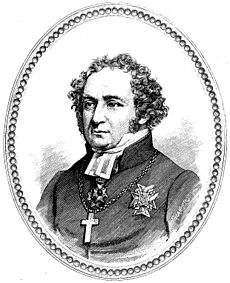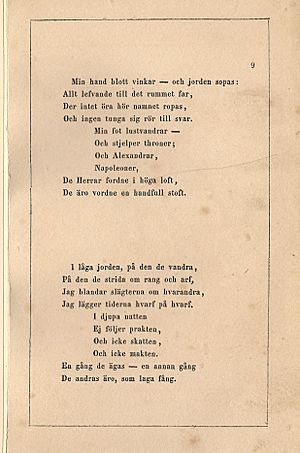Johan Olof Wallin facts for kids
Quick facts for kids The Most Reverend Johan Olof Wallin |
|
|---|---|
| Archbishop of Uppsala Primate of Sweden |
|
 |
|
| Church | Church of Sweden |
| Archdiocese | Uppsala |
| Appointed | 1837 |
| In Office | 1837–1839 |
| Predecessor | Carl von Rosenstein |
| Successor | Carl Fredrik af Wingård |
| Orders | |
| Consecration | 28 March 1824 by Carl von Rosenstein |
| Rank | Metropolitan Archbishop |
| Personal details | |
| Born | 15 October 1779 Stora Tuna, Dalarna, Sweden |
| Died | 30 June 1839 (aged 59) Uppsala, Sweden |
| Spouse | Anna Maria Dimander (1810-1839) |
| Alma mater | University of Uppsala |
Johan Olof Wallin (born October 15, 1779 – died June 30, 1839) was an important person in Sweden. He was a minister, a great speaker, and a poet. Later, he became the Archbishop of Uppsala for the Church of Sweden from 1837 to 1839. Today, he is mostly remembered for the many hymns he wrote.
Contents
Wallin's Early Life and Education
Johan Olof Wallin was born in a place called Stora Tuna in Dalarna, Sweden. He was the oldest son in a big family. Even though his parents didn't have much money, Johan was a very smart student.
He went to school in Falun. In 1799, he was able to enroll at the University of Uppsala. Four years later, he earned his Master of Arts degree. After three more years, he became a minister.
How Wallin Became a Poet
While he was still studying, Johan's first poem was published in a newspaper called Upsala tidningar in 1802. In the years that followed, he wrote many other poems. He also translated works from famous ancient writers like Horace and Virgil.
The Swedish Academy gave him several awards for his writing. For a song he wrote about King Gustav III, he received a large sum of money. Some people thought his early poems sounded a bit old-fashioned. They preferred the new, more emotional style of Romantic poets. Wallin listened to this criticism and changed his writing style to be more modern.
Wallin's Work in the Church
In 1810, Johan Olof Wallin married Anna Maria Dimander. In the same year, he was chosen to be a member of the Swedish Academy. He also took on a big project: creating a new book of hymns for Sweden.
Creating the Swedish Hymn Book
The hymn book project was finished in 1816. The king approved it in 1819, and it was printed that same year. This new book had 500 hymns. Wallin himself wrote 128 of them. He also translated 23 hymns and helped improve 178 others. The way the hymn book was organized was also mostly his idea.
In 1827, he became a member of the Royal Swedish Academy of Sciences. In 1835, Wallin helped start the Swedish Mission Society. This group worked to help the Sámi people, who live in northern parts of Sweden. He started this group with others, including a missionary named George Scott.
Becoming Archbishop
Johan Olof Wallin held many different jobs in the church during his life. His highest position was becoming the Archbishop of Sweden in 1837. This was a very important leadership role in the church.
Sadly, he died suddenly in 1839, before he could even move to Uppsala, where the archbishop lives. He was buried in Stockholm. People across Sweden were very sad when he died. Many said he was a brilliant speaker and preacher. He was known as a talented writer and a very religious man. He was not very strong physically, and his hard work might have made him sick.
Wallin's Impact on Education
Johan Olof Wallin also cared a lot about education, especially for girls. He was the person who started the idea for a pioneering girls' school called Wallinska skolan. This was the fourth serious school for girls in Sweden and the first in the capital city of Stockholm.
He believed that girls should get a more serious education than what was offered at typical finishing schools. He convinced Anders Fryxell to help make this school happen. Wallin was also the president of Pro Fide et Christianismo. This was a Christian education group that helped shape Sweden's early public education system.
Wallin's Lasting Legacy
For many years after his death, writers and thinkers in Sweden greatly admired Wallin. In 1879, some places even celebrated his 100th birthday. A monument was built in his hometown, and a statue of him was revealed in Falun in 1917.
Over time, his reputation changed. Today, he is mainly remembered for the hymns that are still sung in Swedish churches. One of his most famous hymns is the traditional Christmas hymn "Var hälsad, sköna morgonstund" (which means "All Hail to you, O blessed morn").
Besides hymns, Wallin wrote several other poems that were very popular in his time. He also published many sermons and speeches. Some of his hymns have even been translated into English and are used in hymn books in other countries. These include "Du som fromma hjärtan vårdar" ("Christians, while on Earth abiding") and "Vi lovar Dig, O Store Gud" ("We worship you, O God of might").
His writing style is often described as thoughtful and moving. He often wrote about death and included many references to the Bible. His biggest work was a long poem called Angel of Death, which he finished about a year before he died. Some people think he was one of the best Swedish poets of his time, second only to Esaias Tegnér.


